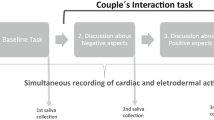Abstract
The primary purpose of this study was to investigate the relationship between spouse marital satisfaction and spouse solicitousness to their physiological responsiveness during marital interactions about pain. Twenty-six couples engaged in a series of structured marital interactions about neutral and pain-related topics while monitored for skin conductance (SC) and heart rate (HR). There was strong support for the role of spouses’ marital satisfaction in predicting their physiological responsiveness. The more satisfied a spouse, the more physiologically reactive the spouses were when listening to the patient describe pain, and the less reactive when responding to it. Dissatisfied spouses demonstrated the opposite pattern. They autonomically deactivated when hearing about the pain and became reactive when responding to it. Solicitousness was not a significant predictor of the spouses’ physiological responsiveness. Block’s (1981) proposed physiological mechanism for the origin of solicitousness in spouses did not receive support. It appears that responding in any fashion may lessen the magnitude of arousal in maritally satisfied spouses, whereas dealing with pain-related topics produces unpleasant arousal in dissatisfied spouses.
Similar content being viewed by others
References
Ahern, D. K., and Follick, M. J. (1985). Distress in spouses of chronic pain patients.Int. J. Family Ther. 7: 247–257.
Andreassi, J. L. (1980).Psychophysiology: Human Behavior and Physiological Response, Oxford University Press, New York.
Batson, C. D., and Coke, J. S. (1983). Empathic motivation of helping behavior. In Cacioppo, J. T., and Petty, R. E. (eds.),Social Psychophysiology: A Sourcebook, Guilford Press, New York, pp. 417–433.
Berger, S. M. (1962). Conditioning through vicarious instigation.Psychol. Bull. 69: 450–466.
Block, A. R. (1981). An investigation of the response of the spouse to chronic pain behavior.Psychosom. Med. 43: 415–422.
Block, A. R., Kremer, E. F., and Gaylor, M. (1980). Behavioral treatment of chronic pain: The spouse as a discriminative cue for pain behavior.Pain 9: 243–252.
Derogatis, L. R. (1983).SCL-90-R Administration, Scoring, and Procedures Manual-II for the Revised Version. Clinical Psychology Research, Towson, MD.
Flor, H., Kerns, R. D., and Turk, D. C. (1987). The role of spouse reinforcement, perceived pain, and activity levels of chronic pain patients.J. Psychosom. Res. 31: 251–259.
Flor, H., Breitenstein, C., Birbaumer, N., and Furst, M. (1995). A psychophysiological analysis of spouse solicitousness towards pain behaviors, spouse interaction, and pain perception.Behav. Ther. 26: 255–272.
Fordyce, W. E. (1976).Behavioral Methods for Chronic Pain and Illness, Mosby, St. Louis.
Kerns, R. D., and Turk, D. C. (1984). Chronic pain and depression: Mediating role of the spouse.J. Marriage Family 46: 845–852.
Kerns, R. D., Turk, D. C., and Rudy, T. E. (1985). The West Haven-Yale Multidimensional Pain Inventory (MPI).Pain 23: 345–356.
Khatami, M., and Rush, A. J. (1978). A pilot study of the treatment of outpatients with chronic pain: Symptom control, stimulus control, and social systems intervention.Pain 5: 163–172.
Kremer, E. F., Sieber, W., and Atkinson, J. H. (1985). Spousal perpetuation of chronic pain behavior.Int. J. Family Ther. 7: 258–270.
Lacey, J. I., and Lacey, B. C. (1974). On heart rate and behavior: A reply to Elliot.J. Person. Soc. Psychol. 30: 1–18.
Levenson, R. W., and Gottman, J. M. (1983). Marital interaction: Physiological linkage and affective exchange.J. Person. Soc. Psychol. 45: 587–597.
Levenson, R. W., and Gottman, J. M. (1985). Physiological and affective predictors of change in relationship satisfaction.J. Person. Soc. Psychol. 49: 85–94.
Locke, H. J., and Wallace, K. M. (1959). Short marital adjustment and prediction tests: Their reliability and validity.Marriage Family Living 21: 251–255.
Lousberg, R., Schmidt, A. J., and Groenman, N. H. (1992). The relationship between spouse solicitousness and pain behavior: Searching for more experimental evidence.Pain 51(1): 75–79.
Maruta, T., Osborne, D., Swanson, D. W., and Halling, J. M. (1981). Chronic pain patients and spouses: Marital and sexual adjustment.Mayo Clin. Proc. 56: 307–310.
Romano, J. M., Turner, J. A., Friedman, L. S., Bulcroft, R. A., Jensen, M. P., Hops, H., and Wright, S. F. (1992). Sequential analysis of chronic pain behaviors and spouse responses.J. Consult. Clin. Psychol. 60(5): 777–782.
Turk, D. C., and Flor, H. (1984). Etiological theories and treatment for chronic back pain. II. Psychological models and interventions.Pain 19: 209–233.
Venables, P. H., and Christie, M. J. (1973). Mechanisms, instrumentation, recording techniques and quantification of responses. In Prokasy, W. F., and Raskin, D. C. (eds.),Electrodermal Activity in Psychological Research, Academic Press, New York, pp. 1–124.
Author information
Authors and Affiliations
Rights and permissions
About this article
Cite this article
Stampler, D.B., Wall, J.R., Cassisi, J.E. et al. Marital satisfaction and psychophysiological responsiveness in spouses of patients with chronic pain. Int J Rehab Health 3, 159–170 (1997). https://doi.org/10.1007/BF02766063
Issue Date:
DOI: https://doi.org/10.1007/BF02766063




